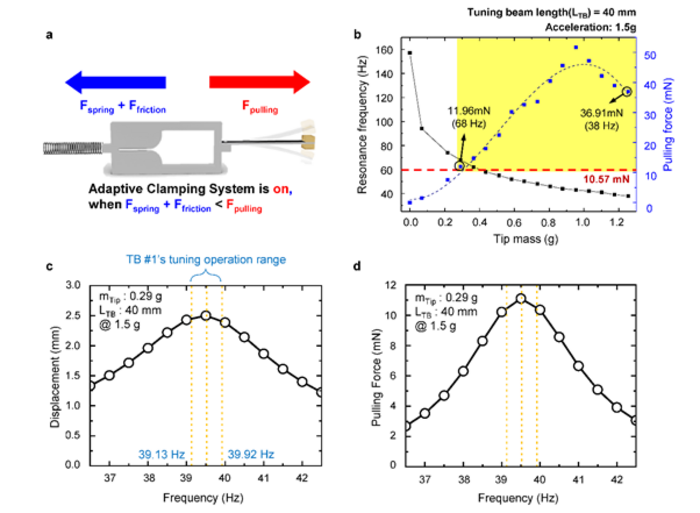Energy harvesting technology collects and transforms waste energy like heat, vibration, light, and electromagnetic waves from everyday settings like buildings, automobiles, and home appliances.

Schematics for energy harvester structure and adaptive clamping system (above). Image Credit: Korea Institute of Science and Technology
By harvesting ambient energy sources, energy harvesters can generate enough electricity to power small electronic devices without the need for an external power supply.
The Korea Institute of Science and Technology (KIST, President Seok Jin Yoon) announced the development of an autonomous resonance tuning (ART) piezoelectric energy harvester by Dr. Hyun-Cheol Song’s research group at the Electronic Materials Research Center. The designed energy harvester can tune its own resonance over a wide bandwidth of more than 30 Hz and transform absorbed vibration energy into electrical energy.
The mechanical energy loss caused by the energy harvesting process that transforms vibration into electrical energy results in low energy conversion efficacy.
This issue can be fixed by utilizing the resonance phenomenon, which occurs when the natural frequency of an object and the frequency of the vibration coincide. While the natural frequency of the energy harvester is fixed, the varying vibrations experienced in daily life have varying frequency ranges.
As a result, to induce resonance, the natural frequency of the harvester must be adapted to the usage environment each time, making it very difficult for practical use.
As a result, the KIST investigators created a specifically made energy harvester that can tune to the surrounding frequency without the use of an external electrical device. When the energy harvester detects external vibration, an adaptive clamping system (tuning system) connected to the harvester modifies its frequency to match the external vibration, allowing resonance.
As a result, it was possible to achieve resonant frequency tuning in less than 2 seconds while constantly producing electricity in a range of more than 30 Hz.
This energy harvester with a tuning system was positioned on a driving vehicle for real-world validation of the ART function. Unlike previous studies’ piezoelectric energy harvesters, it effectively drove a wireless positioning device without a battery in an environment where the vibration frequency altered constantly.
This result suggests that energy harvesters using vibrations can be applied to our real life soon. It is expected to be applicable as an independent power source for wireless sensors, including the IOT, in the future.
Dr. Hyun-Cheol Song, The Korea Institute of Science and Technology
Journal Reference
Lee, D.-G., et al. (2022) Autonomous Resonance-Tuning Mechanism for Environmental Adaptive Energy Harvesting. Advanced Science. doi.org/10.1002/advs.202205179.